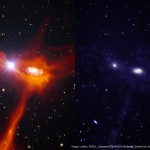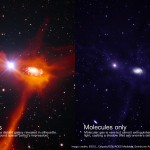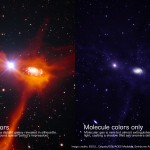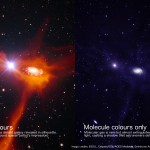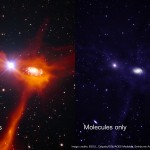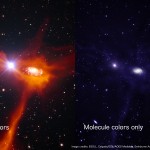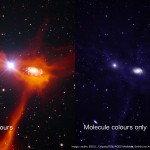Galaxy silhouettes reveal few seeds for new stars
Molecules in space are rare, rarer than we thought!
See the Swinburne University of Technology and University of Hawaii media releases. Images associated with this release are provided below.
We’ve just published a search for molecules around young galaxies, and we found precious few out there! Molecules are thought to be the seeds from which new stars can form, but we looked at galaxy outskirts at a time when the universe was most actively forming stars and we didn’t find much.
This apparent conundrum probably means that molecules are in special places – probably within galaxies themselves – and not where most of the gas is, i.e. just outside galaxies in what we call the circumgalactic medium (or, technically, in ‘damped Lyman alpha systems’).
Our new survey was conducted on the 6.5-metre Magellan telescopes in Chile. We searched the gas surrounding galaxies within 1 or 2 billion years of the Big Bang (which happened 14 billion years ago) using a special technique called quasar absorption spectroscopy. We can’t see the gas directly – it doesn’t have (many) stars, so there’s no starlight to see – so instead we observe it in silhouette: we looks for the absorption lines it imprints on the light from a background object as it passes through the galaxy on its way to us here on Earth.
Previous studies had found molecular hydrogen around about 10% of young galaxies. However, we found just 1 case out of 90. That is, we found that molecules are rarer than previously thought. Therefore, most of the gas in the universe seems not to be in the right place, or in the right state, to form stars. It probably has to fall into, and settle down, within galaxies before that can happen.
Find the details in our paper, now published:
Jorgenson R.A, Murphy M.T., Thompson R., Carswell R.F.,
The Magellan Uniform Survey of Damped Lyman α Systems II: Paucity of Strong Molecular Hydrogen Absorption,
2014, Mon. Not. Roy. Astron. Soc., 443, 2783, arXiv:1407.1111.
- Image: Artist’s impression of the gas surrounding a young galaxy in the distant universe. The gas, shown as red streams on the left, is actually invisible, and the starlight from the galaxy is too faint for astronomers to see directly. Instead, the gas is seen in silhouette against a bright, background quasar. Molecules in the gas imprint a shadow, or absorption line, onto the quasar light at a very specific colour, as seen on the right, and astronomers can detect this shadow. Image credits: ESO/L. Calçada/ESA/AOES Medialab, Swinburne Astronomy Productions
- Image: Artist’s impression of the gas surrounding a young galaxy in the distant universe. The gas, shown as red streams on the left, is actually invisible, and the starlight from the galaxy is too faint for astronomers to see directly. Instead, the gas is seen in silhouette against a bright, background quasar. Molecules in the gas imprint a shadow, or absorption line, onto the quasar light at a very specific colour, as seen on the right, and astronomers can detect this shadow. Image credits: ESO/L. Calçada/ESA/AOES Medialab, Swinburne Astronomy Productions
- Image: Artist’s impression of the gas surrounding a young galaxy in the distant universe. The gas, shown as red streams on the left, is actually invisible, and the starlight from the galaxy is too faint for astronomers to see directly. Instead, the gas is seen in silhouette against a bright, background quasar. Molecules in the gas imprint a shadow, or absorption line, onto the quasar light at a very specific colour, as seen on the right, and astronomers can detect this shadow. Image credits: ESO/L. Calçada/ESA/AOES Medialab, Swinburne Astronomy Productions
- Image: Artist’s impression of the gas surrounding a young galaxy in the distant universe. The gas, shown as red streams on the left, is actually invisible, and the starlight from the galaxy is too faint for astronomers to see directly. Instead, the gas is seen in silhouette against a bright, background quasar. Molecules in the gas imprint a shadow, or absorption line, onto the quasar light at a very specific colour, as seen on the right, and astronomers can detect this shadow. Image credits: ESO/L. Calçada/ESA/AOES Medialab, Swinburne Astronomy Productions
- Image: Artist’s impression of the gas surrounding a young galaxy in the distant universe. The gas, shown as red streams on the left, is actually invisible, and the starlight from the galaxy is too faint for astronomers to see directly. Instead, the gas is seen in silhouette against a bright, background quasar. Molecules in the gas imprint a shadow, or absorption line, onto the quasar light at a very specific colour, as seen on the right, and astronomers can detect this shadow. Image credits: ESO/L. Calçada/ESA/AOES Medialab, Swinburne Astronomy Productions
- Image: Artist’s impression of the gas surrounding a young galaxy in the distant universe. The gas, shown as red streams on the left, is actually invisible, and the starlight from the galaxy is too faint for astronomers to see directly. Instead, the gas is seen in silhouette against a bright, background quasar. Molecules in the gas imprint a shadow, or absorption line, onto the quasar light at a very specific colour, as seen on the right, and astronomers can detect this shadow. Image credits: ESO/L. Calçada/ESA/AOES Medialab, Swinburne Astronomy Productions
- Image: Artist’s impression of the gas surrounding a young galaxy in the distant universe. The gas, shown as red streams on the left, is actually invisible, and the starlight from the galaxy is too faint for astronomers to see directly. Instead, the gas is seen in silhouette against a bright, background quasar. Molecules in the gas imprint a shadow, or absorption line, onto the quasar light at a very specific colour, as seen on the right, and astronomers can detect this shadow. Image credits: ESO/L. Calçada/ESA/AOES Medialab, Swinburne Astronomy Productions
